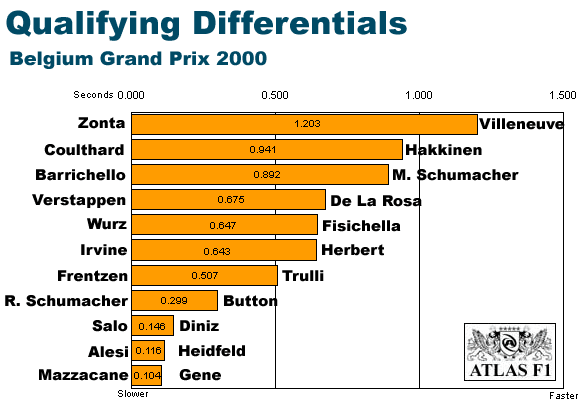|
Atlas F1 is going to keep an eye on the battle between teammates throughout the season with a simple measurement: we compare the qualifying times of each driver against his teammate's result. After every Grand Prix, we will show how teammates have fared up against each other, and where they are overall since the beginning of the season. At the end of the season, the World Champion of Qualifying Differentials will be elected - the driver who was most beaten by his teammates, in seconds. Only those who participate in at least 15 of the 17 rounds are eligible for the coveted crown; and for those who made the efforts and participated in all 17 races, the best and worst result will be scrapped.
With thirteen qualifying sessions completed for 2000, the differentials are on a roll! Let's see which drivers deserve bragging rights.
Belgium Notables
- Button. It took Michael Schumacher eight Grands Prix to qualify on the front two rows of the grid; it took Mika Hakkinen more than a season to achieve the same feat. Rarely do rookies make an appearance in the post-qualifying press conference room while driving a non-championship car, and on Saturday Jenson Button added yet another achievement to his remarkable first F1 season. One can only imagine how Button will perform in his second season, if only his car will be at least as good as the Williams-BMW.
- Fisichella. Kudos to the talented Italian - Giancarlo Fisichella had only one run in qualifying, in a car that was set up for his teammate, Alexander Wurz. And yet, he qualifying a respectable eleventh and once again stomped Wurz, outqualifying him by over half a second.
- The McLaren Pair. Perhaps if David Coulthard wasn't too busy having a pissing contest with Heinz Harald Frentzen, he would have been able to maintain the marginal lead he's had over Mika Hakkinen in the differentials averages. But as things stand, and with literally nothing between the two, it would only take another qualifying session for Coulthard to end yet another season behind his teammate, and in every sense possible.
- Changes since Hungary: Jarno Trulli resumed his position by overtaking teammate Heinz Harald Frentzen to be on the faster side of the equation.
The average gap between teammates in Belgium was... well, average: 0.561 of a second. Previously, the average in Hungary was 0.584, compared with Germany's 1.072; Austria's 0.288s; France's 0.400; Canada's 0.449; 0.486 in Monaco; 0.546s in Europe; 0.48s in Spain; 0.725s in Britain; 0.654s in San Marino; 0.455s in Brazil; and 0.874s in Australia.
|


